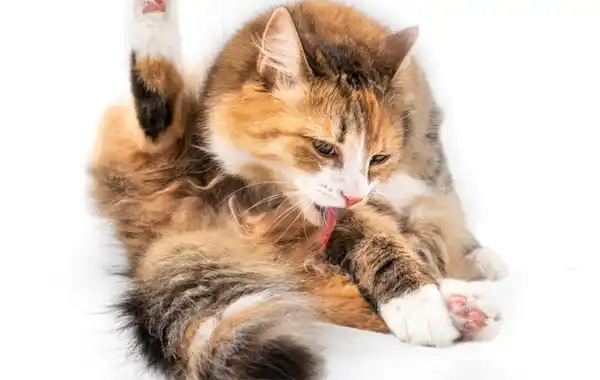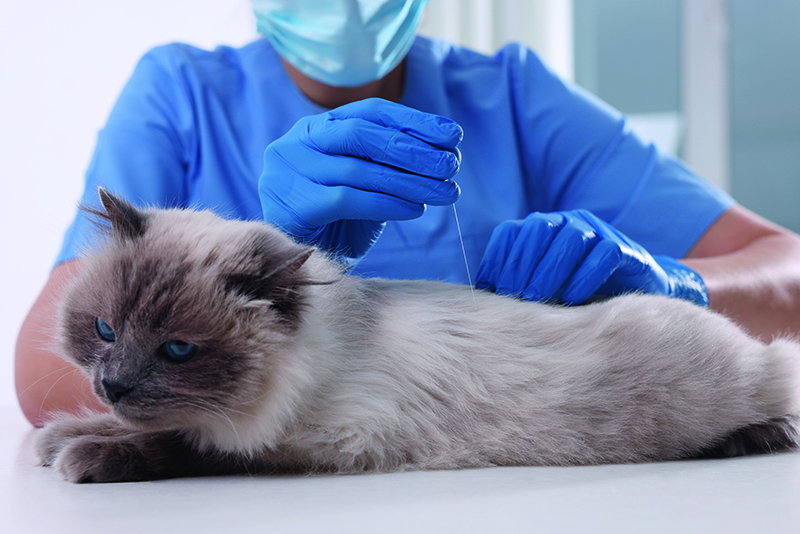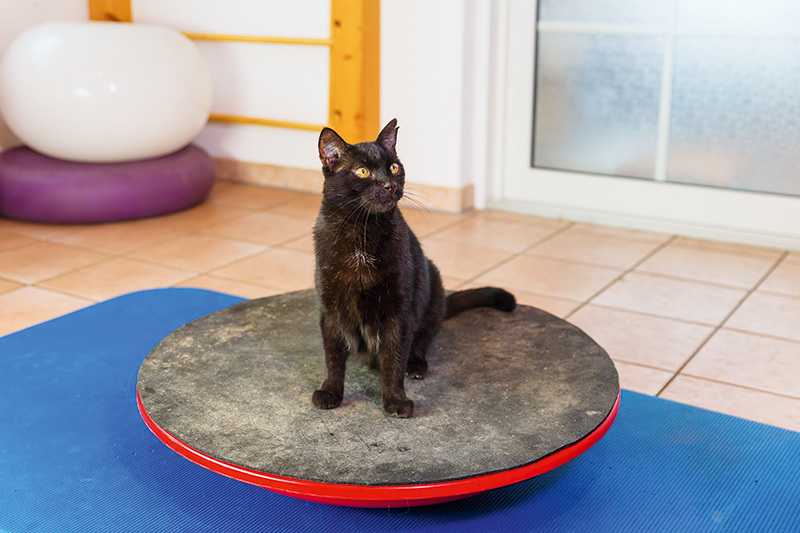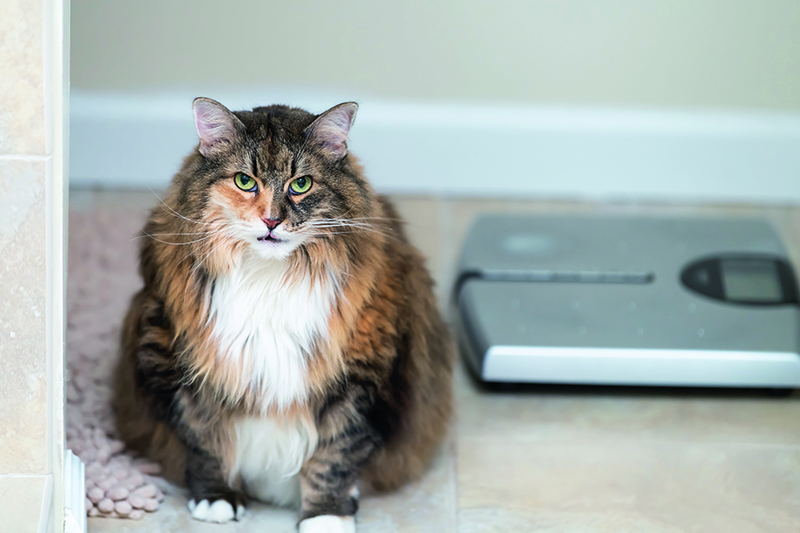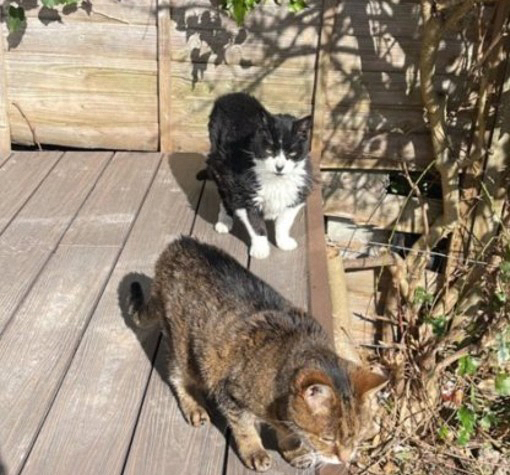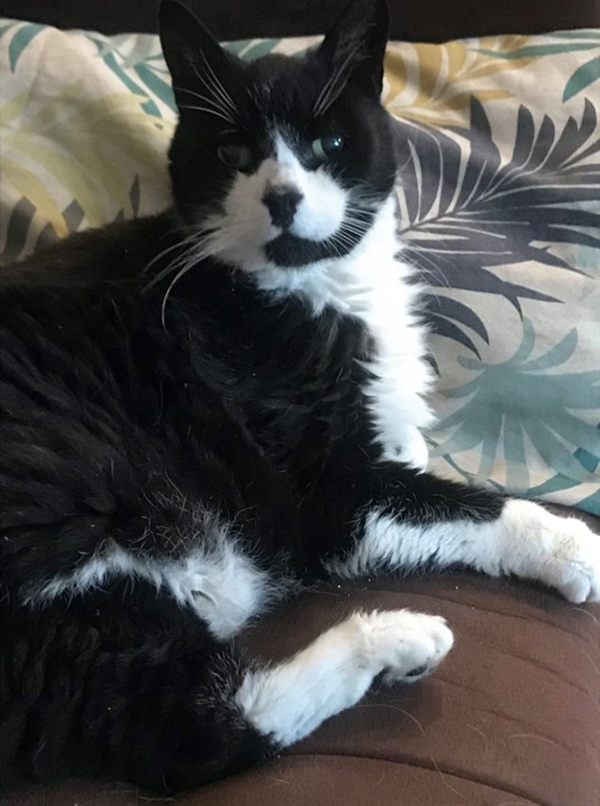Arthritis affects an incredibly high number of cats. Vet Penny Clarke explains all about the condition and how to manage it.
It’s now routine in our house that if Jasper (my 19-year-old cat) is sitting at the bottom of the stairs, we carry him up. Some days he manages a slow ascend by himself but mostly he waits for his humans. Jasper has osteoarthritis, a common condition affecting middle aged and older cats.
If your cat is slowing down (and they don’t have underlying health issues), they could be in pain from osteoarthritis. Studies show that nearly two thirds of all cats over six years of age have signs of osteoarthritis. For cats over 12, this increases to 90 percent — that’s a lot of creaking cat joints!
What is osteoarthritis?
Osteoarthritis is a degenerative condition affecting one or more of your cat’s joints (usually the elbows and hips but sometimes their hocks (ankles), the vertebra (back bone), the sternum (chest bone), and shoulders). Over time, the cartilage cushion inside the joint breaks down. Without this padding, surfaces of the bone start to rub together causing pain and movement issues. Sometimes new spurs of bone form around the joint causing further pain and worsening mobility. While no cure is available, there’s a lot you can do to help slow the progression of your cat’s osteoarthritis and keep them comfortable for as long as possible.
What are the signs?
Often the first signs you notice are behavioural changes:
● Fur changes Cat grooming involves some fairly advanced yoga moves and cats with osteoarthritis often struggle to flex their bodies enough so develop matted areas of fur.
● Less sociable than usual Osteoarthritis makes cats feel depressed too so they often withdraw from family life. As well as being less sociable, they can become grumpier too. Your cat might lash out when you inadvertently stroke over their sore joints or lift them up where it hurts.
● Toilet accidents It’s more difficult for cats with osteoarthritis to hold themselves in position long enough to finish passing stools normally. Without realising, they may drop the odd ‘present’ on the floor or even miss their tray completely. Some cats avoid climbing into their tray and find alternative toileting arrangements (behind the sofa for example!).
● Less jumping and climbing Your cat may adjust how they move or avoid jumping and climbing completely. Some cats ‘bunny hop’ up the stairs rather than moving their legs separately. Even on short flights of stairs, cats with osteoarthritis often stop for a break midway. Coming down the stairs is also challenging; some cats descend at an angle to reduce the pressure placed on their sore elbows and shoulders.
Cats also find jumping on to high surfaces (such as beds and sofas) more difficult. Rather than leap in one go, cats might use their claws like climbers’ crampons to pull themselves up.
Climbing up and down stairs can be a real challenge for cats with arthritis.
Physical signs of osteoarthritis
Cats don’t always limp when they have osteoarthritis. There are a number of reasons for this:
● Osteoarthritis usually affects the same joints on both sides of the body. Surrounding muscle groups and joints work harder to adapt and mask mobility issues (especially during the early stages).
● Cats are naturally agile and light.
● Even if they feel stiff after rest, cats usually ‘loosen up’ quickly.
Many of the physical signs of osteoarthritis relate to general pain so can be easily mistaken for other conditions. If your cat shows any signs of pain, speak to your vet for advice.
Physical signs of osteoarthritis include:
● Weight loss — cats in pain generally eat less. Osteoarthritis also causes muscle atrophy (loss of muscle mass).
● Hunched appearance — stretching out is painful for cats with osteoarthritis.
● Facial grimace — vets in clinical settings use cats’ facial expressions to assess pain. Ears flattened on to their head and a tense, pinched facial expression are indicators of discomfort.
● Tail flicking — if your cat flicks their tail rapidly when you stroke them, it could be a sign of pain
Diagnosing osteoarthritis
Most cats behave differently at the vet’s and may cower on the consulting table, refusing to move at all. It’s handy to write down all the changes you’ve noticed about your cat as this helps your vet work out whether osteoarthritis is the cause.
Your vet will carry out a full physical examination including an orthopaedic check (where they manipulate your cat’s joints and muscles). Unlike dogs, cats don’t get joint crepitus (a ‘crunchy’ feeling in the joints). Instead, the tissue around their arthritic joints feels thickened and swollen.
Often your history combined with your vet’s examination is enough to suspect your cat has osteoarthritis. Your vet may suggest imaging your cat’s joints to look in more detail. X-rays and CT scans are both useful for this. Weirdly, signs of feline osteoarthritis don’t always show on X-rays. And if radiographic signs are present, they may not correlate with the physical changes your cat is showing. One study found only 10 per cent of cats with osteoarthritis have visible changes on X-rays.
Acupuncture may help ease the symptoms.
Available medical treatments
Non-steroidal anti-inflammatories (NSAIDs)
These anti-inflammatory painkillers are effective and safe when given correctly. Most cats readily accept it on their food. Your vet will run regular (usually yearly or every six months) blood tests to check your cat’s kidney and liver function.
Monoclonal antibody treatment
This new medication blocks a chemical called nerve growth factor (NGF) that causes pain in joints with osteoarthritis. It has few side effects so is safe for cats with other health issues, such as kidney disease.
Other pain killers
Your vet might prescribe additional pain relief including: buprenorphine, amantadine, tramadol, or gabapentin. It very much depends on your cat’s individual needs and how easy they are to medicate.
Acupuncture
Only vets can carry out acupuncture in cats (unlike in humans where practitioners don’t need to be doctors). Your vet will place needles in specific points on your cat’s body to stimulate the release of chemicals that have pain relieving properties. Many cats find the experience relaxing but some won’t tolerate the needle placement.
Dietary supplements
These contain substances that form the building blocks of joint cartilage to help repair damaged joints. Active ingredients include essential fatty acids, glucosamine, chondroitin, and green lipped mussel extract. It’s uncertain how effective these supplements are (and the quality of products can vary greatly) but they are usually safe when given according to your vet’s instructions. Some prescription diets contain ingredients thought to improve osteoarthritis. Ask your veterinary team to recommend one.
Physiotherapy and hydrotherapy
Believe it or not, some cats tolerate hydrotherapy very well! (An underwater treadmill rather than a pool is ideal.) Hydrotherapy helps rebuild muscles to better support arthritic joints. Your veterinary practice may have their own facilities or can recommend a local cat-friendly centre.
A veterinary physio can give you simple exercises to do at home with your cat to help keep their joints mobile and strengthen muscles. With a bit of practice (and bribery), these exercise can become a nice bonding experience for you and your cat.
Environmental changes
Adapting your home to help your cat doesn’t need to cost much but can make a huge difference to their quality of life.
● Pad it out — increase the cushioning on your cat’s favourite bed and make sure it’s in a warm, draught-free place.
● Steps — homemade steps made from boxes (or carpet-covered wooden ramps) help your cat reach their favourite higher places (beds, sofas and windowsills).
● Check your cat flap is working properly and that your cat can easily reach it.
● Keep their essential amenities (food, water, and litter tray) on the ground floor.
● Groom and clean your cat to keep their fur and skin in good condition. Trim their claws if they become overgrown.
● Switch to a low-sided litter tray.
Veterinary physiotherapy can be really beneficial.
What else can you do?
There’s no official evidence to support whether being overweight increases a cat’s chances of getting osteoarthritis. However, we do know that keeping cats at a healthy weight can improve their symptoms. And it’s logical to assume that having less weight to carry puts joints under less stress.
Cats with osteoarthritis can still lead full, happy lives. They may take things a little easier but bird watching while lying on a soft cushion in the sun doesn’t sound too bad, does it?
Being overweight can make the condition tougher for your cat to cope with.
Environmental changes
Adapting your home to help your cat doesn’t need to cost much but can make a huge difference to their quality of life.
● Pad it out — increase the cushioning on your cat’s favourite bed and make sure it’s in a warm, draught-free place.
● Steps — homemade steps made from boxes (or carpet-covered wooden ramps) help your cat reach their favourite higher places (beds, sofas and windowsills).
● Check your cat flap is working properly and that your cat can easily reach it.
● Keep their essential amenities (food, water, and litter tray) on the ground floor.
● Groom and clean your cat to keep their fur and skin in good condition. Trim their claws if they become overgrown.
● Switch to a low-sided litter tray.
Case study:
“He still clearly enjoys life”
My cat Jasper was never the most active of cats but he did go through a brief phase of catching frogs! My other cat, Maisie (also 19 years old), is the
tree-climbing explorer and he’s more of an observer.
Jasper was in his early teens when I realised he was slowing down and avoiding jumping on to furniture. Sometimes after rest he seemed stiff (especially on his front legs) but soon loosened up. During warmer weather, his symptoms disappeared (he loves to stretch out in the sun) but on damp, cold days he didn’t seem quite as happy.
Jasper (top) still enjoys life.
Jasper gets help climbing stairs.
I started giving Jasper nutritional supplements and a daily non-steroidal anti-inflammatory pain killer. Very quickly he resumed his usual activities (mainly snoozing on our beds!) This suited him for a few years but from about the age of 16, he needed more help.
I am no DIY-er but I covered a plastic box in carpet and placed it in front of his favourite sofa. Immediately, he started hopping on to his new step and now spends much of his time using the actual box as a bed too!
Jasper has always been keen on his food whereas Maisie prefers to graze. We monitor meal times closely otherwise Jasper ends up having two dinners. His bodyweight is OK but if he ate ad-lib he would certainly take advantage and be a bigger cat!
Acupuncture really helps many of my patients who have osteoarthritis so I thought I’d try it out on Jasper. (I trained in veterinary acupuncture many years ago.) He made it very clear, very quickly that it wasn’t for him!
For the last few months, Jasper has been having injections of a new medicine containing monoclonal antibodies that target osteoarthritis. He still has his other medication too and the combination really suits him.
Although Jasper spends much of his day snoozing now, he still clearly enjoys his life, especially his food. His simple routine suits him and we happily carry him up the stairs when he ‘asks’ for help. He has always loudly expressed his demands!







